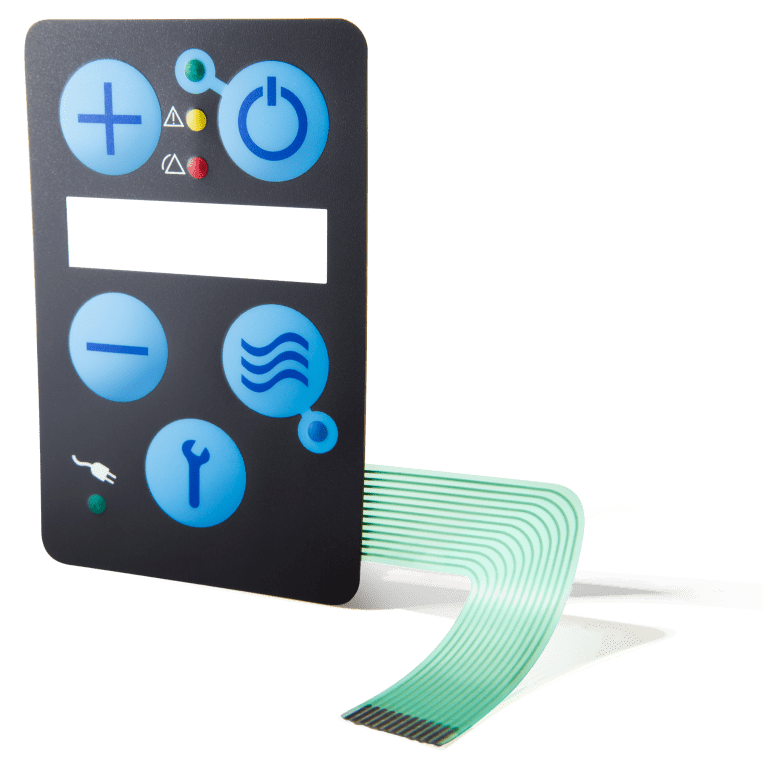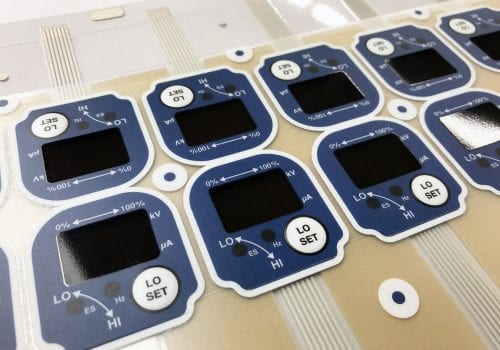The Manufacturing Refine Behind Membrane Switch Over: What You Need to Know
The production process behind membrane layer changes combines mindful style, product choice, and quality assurance. It begins with recognizing the complexities of membrane layer switch layout and progresses with various stages, consisting of material choices and printing techniques. Each stage plays an important duty in guaranteeing capability and resilience. The complexities of layer building and the strenuous testing requirements might disclose understandings that are not right away obvious. What lies past these fundamental components?
Understanding Membrane Layer Switch Over Design
Membrane switches might show up basic at initial look, their layout involves intricate considerations that guarantee performance and toughness. The layout procedure starts with a comprehensive understanding of user requirements, including the interface's intended application and environmental factors. Functional designs is a crucial element, as the design should help with ease of use while ensuring that tactile responses fulfills individual expectations.Moreover, the layering of elements, such as graphic overlays, adhesive layers, and conductive traces, must be precisely crafted. membrane switch. This split setup not only influences the button's responsiveness however likewise affects its longevity. Attention is given to the securing methods employed to protect versus dampness and dust, which could endanger efficiency. Furthermore, design factors to consider expand to looks, where color pattern and aesthetic clearness enhance customer experience. Ultimately, the layout of membrane switches equilibriums functionality, customer experience, and toughness, making sure that they satisfy the needs of various applications efficiently
Materials Made Use Of in Membrane Change Manufacturing
When choosing materials for membrane layer switch production, it is important to consider both efficiency and sturdiness. The primary products consist of polyester and polycarbonate movies, which provide versatility and toughness. These films are frequently coated with sticky to assure appropriate bonding to substrates. Conductive inks, generally made up of silver or carbon, are crucial for developing electrical links within the button, permitting dependable operation.Additionally, a safety layer, such as a hard coat, is often put on boost scratch resistance and long life. The option of backing product, such as acrylic or foam, can significantly influence the button's responsive feel and overall individual experience. Additionally, numerous ecological aspects, including temperature and moisture, ought to lead product choice to ensure peak efficiency in details applications. Inevitably, the best mix of products adds to the membrane layer button's functionality and lifespan, making notified options vital for manufacturers.
The Printing Process: Creating Graphics and Text
The printing procedure in membrane layer switch production plays a considerable duty in creating top notch graphics and text. Different visuals style methods are employed to guarantee visual appeal and functionality, while cautious ink selection approaches are crucial for resilience and performance. Comprehending these aspects is basic for accomplishing ideal lead to membrane switch style.
Graphic Style Techniques
Graphic style techniques play an important role in the printing process of membrane switches, as they specify exactly how graphics and message will inevitably show up on the end product. Effective graphic design entails the tactical use colors, fonts, and layouts to boost readability and visual charm. Designers often utilize vector graphics for scalability, making sure that pictures continue to be sharp at different sizes. In addition, focus to contrast and placement is essential, as it influences customer communication and aesthetic top quality. The unification of branding elements, such as logos, have to be handled with treatment to maintain brand integrity. Generally, thoughtful graphic layout strategies add considerably to the capability and attractiveness of membrane layer buttons, impacting individual experience and product efficiency.
Ink Selection Methods
Picking the appropriate ink is vital for accomplishing the preferred aesthetic high quality and resilience in membrane layer button manufacturing. Numerous ink types are used, including solvent-based, water-based, and UV-curable inks. Each type provides unique qualities, such as resistance, adhesion, and versatility to environmental elements. Solvent-based inks are typically preferred for their sturdiness and lively shades, while water-based inks are much more eco friendly however might have limitations in attachment. UV-curable inks offer quick curing and robust efficiency. Additionally, color matching strategies guarantee that the chosen inks line up with layout specs. Inevitably, the choice of ink should think about factors such as application technique, substrate compatibility, and end-use demands to attain exceptional lead to membrane switch graphics and message.
Layer Construction and Assembly

Product Option Refine
A cautious selection of products is vital in the production process of membrane buttons, as it directly influences capability and durability. The primary materials utilized consist of polyester, polycarbonate, and different conductive inks. Polyester is usually preferred for its outstanding resistance to chemicals and abrasion, making it ideal for extreme environments. Polycarbonate, on the other hand, supplies superior clarity and impact resistance, which is beneficial for applications calling for exposure great post to read and robustness. Conductive inks, commonly composed of silver or carbon, are vital for creating trusted electrical pathways. Furthermore, the option of sticky products impacts the total honesty of the switch - membrane switch. Evaluating variables such as environmental direct exposure, tactile comments, and visual needs guides manufacturers in picking the most effective products for their details applications
Layer Attachment Methods
Sticking layers in membrane switch building is an important procedure that assures performance and long life. Various adhesion techniques are used to safeguard optimal bonding in between layers, which usually include the usage of adhesives, warmth, and pressure. Pressure-sensitive adhesives (PSAs) are commonly utilized for their ease Website of application and instant bonding capacities. Furthermore, thermal bonding techniques can be applied, where heat is utilized to activate sticky residential properties, protecting a strong bond. The choice of adhesion method mainly depends on the materials involved and the certain application demands of the membrane layer button. Appropriate positioning and consistent application of adhesives are necessary to avoid issues, securing the button operates efficiently throughout its designated life expectancy.
Top Quality Control Procedures
Ensuring high quality control during the layer building and assembly of membrane switches is essential for preserving efficiency and reliability. This procedure commonly involves numerous crucial actions, including thorough evaluations at each stage of production. Makers utilize advanced testing methods, such as peel tests and attachment assessments, to confirm the honesty of layer bonds. Additionally, visual assessments are carried out to determine any kind of problems in printing or material inconsistencies. Ecological problems, such as temperature level and moisture, are meticulously kept an eye on to ensure ideal curing and bond. Furthermore, normal calibration of equipment helps maintain accurate production standards. By executing these quality assurance procedures, producers can substantially minimize the danger of item failing, assuring that the last membrane layer changes fulfill the called for requirements and client assumptions.
Testing and Quality Control Procedures

Developments in Membrane Switch Over Modern Technology
As improvements in innovation continue to advance, membrane layer buttons are benefiting from cutting-edge advancements that boost their functionality and individual experience. One significant technology is the integration of capacitive touch modern technology, which enables even more intuitive and responsive individual interfaces. This shift not only improves aesthetic appeals however also lowers mechanical wear and tear, expanding the life expectancy of the switches.Additionally, developments in graphic overlay products have brought about enhanced longevity and resistance to environmental variables such as wetness and UV light. These materials currently use improved quality and brightness, additional elevating the visual appeal.Furthermore, the consolidation of smart innovation is changing membrane layer changes right into interactive control board, allowing connectivity with IoT gadgets. This connectivity cultivates a seamless individual experience, leading the way for applications in different markets, from healthcare to consumer electronic devices. Jointly, these developments position membrane layer changes as essential components in contemporary tool layout.
Regularly Asked Inquiries
For how long Does the Membrane Layer Switch Production Refine Take?
The duration of the membrane layer switch production procedure can vary significantly. Factors such as complexity, products made use of, and production quantity impact timelines, with common production varying from a few days to a number of weeks for completion.
What Are the Typical Applications for Membrane Buttons?
Membrane layer buttons are frequently used in numerous industries, consisting of automobile controls, household devices, clinical devices, and customer electronic devices (membrane switch). Their convenience and sturdiness make them perfect for applications calling for straightforward user interfaces and trustworthy performance in diverse atmospheres
Can Membrane Layer Switches Over Be Customized for Specific Demands?

What Is the Life-span of a Typical Membrane Change?
The lifespan of a normal membrane layer button differs, but usually, it varies from 1 to 5 million cycles. Elements such as use, environment, and material top quality substantially influence sturdiness and total performance in time.

Are Membrane Layer Switches Eco-friendly?
The ecological friendliness of membrane changes differs. Some materials used might not be recyclable, while others can be eco-friendly. The total influence relies on making products and methods, requiring mindful consideration throughout option and disposal. The production procedure behind membrane switches over combines mindful style, product selection, and top quality control. It starts with comprehending the complexities of membrane layer button design and proceeds with various stages, consisting of product options and printing techniques. When selecting materials for membrane button manufacturing, it is important to ponder both performance and longevity. A cautious option of products is vital in the production process of membrane layer buttons, as it straight affects performance and durability. The choice of bond technique largely depends on the products entailed and the details application needs of the membrane layer switch.
Comments on “How membrane switch interfaces are evolving the future of healthcare equipment”